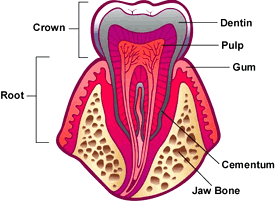 A Root Canal is a procedure used by dentists to save a tooth that is damaged, decayed or the nerve is infected. Root canals have the reputation of being painful, but usually feel the same as getting a filling.
A Root Canal is a procedure used by dentists to save a tooth that is damaged, decayed or the nerve is infected. Root canals have the reputation of being painful, but usually feel the same as getting a filling.
All teeth have three main layers. The outermost layer, the enamel, is made up of minerals and is the strongest material in the body. It is the first layer of defense against bacteria and plaque. Enamel has no nerves and thus no sensitivity. Under the enamel is a layer called dentin. This layer, when exposed due to cracks, cavities or other damage in the enamel, is what causes sensitivity or pain. Recession around the gum line can also expose the dentin and lead to sensitivity. The innermost layer of the tooth, called the pulp, is made up of blood vessels and nerves that feed the cells in the tooth and keep it alive. Blood vessels and nerves run from the jawbone through the “root canals” into the pulp of each tooth. The pulp and dentin layers keep the tooth healthy and repair minor damage. If the damage is too extensive, or the tooth has suffered trauma, the pulp can get infected and bacteria takes over. The tooth can become abscessed, causing pain, pressure, swelling and bone loss.
During a the root canal procedure, we numb the tooth with local anesthesia and then remove the nerve and pulp with tiny instruments. The tooth can survive without the nerve, the sensory input it provides (hot and cold) is not totally necessary for health. Most front teeth have one canal, the premolars have two and the molars have three canals that are cleaned out. Because all teeth are unique, we take x-rays to make sure all canals are clean and empty. After x-rays, the root canals are sealed and filled to prevent bacteria from entering the tooth.
After a root canal, the tooth may be weaker and more brittle, so it can crack or break more easily than before. Depending on the situation, we may recommend a crown for the tooth. For example, if the tooth already had a large filling, or the tooth had cracked enough to require the root canal. It is very important to protect the tooth from further damage, because it is now unable to repair itself from the inside like the other teeth.
Please call us if you have the following symptoms:
- Severe tooth pain when chewing
- Swollen or tender gums
- Lingering sensation of hot and cold, long after the trigger has been removed
- Darkened areas or spots on your teeth
- Persistent grinding (bruxism) which can cause fractures (Please let me know if you have a problem with clenching or grinding because a mouth guard may prevent future root canals)
After a root canal, your tooth may feel more sensitive, especially if you were in pain before the procedure. The inflammation will subside in several days and can be relieved with over the counter pain relievers. Of course, as with any dental procedure, call us right away if the pain is worsening or you experience new symptoms.
Dr. Brent Adams
